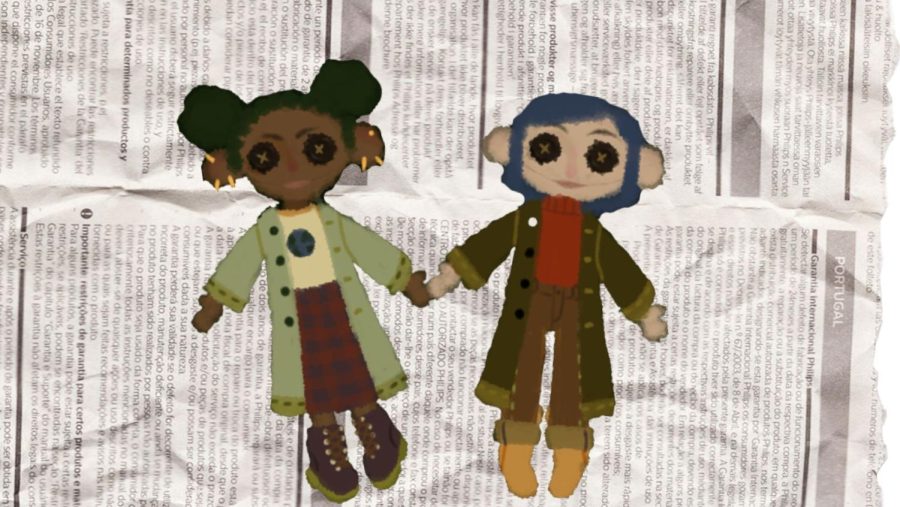“Coraline” vs. “Wendell and Wild”: The battle of the horrors
Since Henry Selick released the renowned “Coraline” movie in 2009, no other stop-motion horror came close to reaching its popularity. However, Selick and director Jordan Peele released a new, similar film called “Wendell and Wild”. Similarities include the topics of family, childhood trauma, symbolism and a multitude of other elements. Perhaps “Coraline” meets its match or maybe “Wendell and Wild” will fail to reach the bar that Coraline set 13 years ago.
December 9, 2022
Recently Jordan Peele released a new movie called “Wendell and Wild”, adding to the short list of stop-motion horror movies to date. It tells the story of a young girl named Kat Elliott who suffers a slew of emotions caused by her parent’s fatal death in a car crash. The 2009 film “Coraline” shares a multitude of similarities with “Wendell and Wild” such as themes of family, feelings of neglect, and girls’ empowerment.
“Wendell and Wild” stands on the theme of childhood trauma and its effect on the mental state of a child. As a result of her parent’s death, Kat attended a boarding school where she barely interacted with her peers. Two demons named Wendell and Wild represent Kat’s feelings of guilt and resentment toward herself. She suffered frequent panic attacks and likely suffered from an illness that stemmed from her past trauma. Similarly, “Coraline” surrounded themes such as abuse, abandonment and generational trauma. Coraline lacks a positive relationship with her parents and it shows at the beginning of the movie. Her father slaves away in an office, hypnotized by a computer adjacent to stacks upon stacks of paperwork. Her mother rarely pays any attention to her and she essentially feels abandoned.

Although the personalities of Kat and Coraline seem different, their stories look very similar. Kat wears knee-high boots, dyes her hair green, and listens to loud rock music. In contrast to Kat, the majority of the other kids in the movie seem entitled, bratty, and stuck up. Coraline also differs from the people around her. Her blue hair pops out in comparison to other characters, and her bright yellow rain jacket displays her warm, sprightly personality. She usually shies away from the crowd and refrains from interaction until she meets Wybie. Both main characters differ drastically from the other characters in the movies. Using these unique elements adds to the girl empowerment factor that makes both films extremely popular.
“The music and artistic choices caught my eye when I first saw it. I saw “Coraline” for the first time fully last year because my sisters watched it when they were little and it scared them so bad that I just never saw it. Watching “Coraline” makes me curious about what I would do if I met my “Other” family. I like to watch the transition between Other Mother from the perfect to a horrific mother as Coraline realizes she’s better off with her real-life mom,” magnet senior Claire Scafidi said.
However, in contrast to “Wendell and Wild”, “Coraline” by far expands on its themes in an extraordinarily complex fashion. “Coraline explicitly” exhibits themes such as courage, family, fear, trauma, perception of reality and identity. From the beginning of the film, Coraline took on the role of the heroic young girl who embarks on a mission to solve the problem at hand. Her courage begins at the first discovery of the small hidden door on her living room wall. Following this event, every other theme begins to unfold throughout the story. Although “Wendell and Wild” also focuses on family and family-related trauma, “Coraline” took it to another level. The entire basis of the movie surrounded the fact that Coraline did not receive the attention she needed from her parents. She turned to seek an alternative reality–real or fictional– to cope with her emotions and the way her family treated her.
“I think Coraline’s real-world life emphasizes the dreariness of working and staying in the same job or role for the rest of your life. Overall I think the whole movie is about conformity. Other mother wants Coraline to conform to her lifestyle and the real-world parents conform to the lifestyle that’s expected, causing Coraline to be bored and sad,” Scafidi said.
Since family and trauma factors of “Coraline” coordinate, the fear factor stands as the next key theme. Although critics named “Wendell and Wild” a horror comedy film, it certainly does not reach the standards that “Coraline” set for a stop-motion horror film. Before Coraline’s encounter with her other parents, the movie already incorporated eerie elements such as the dilapidated garden, the gray, dull color scheme, Mr. Bobinksy’s pale pasty skin and musty clothing, and the dreary atmosphere of Coraline’s new house. Although the directors meant for it to emulate a similar mood with the ever-present dark lighting, “Wendell and Wild” seemed colorful and vibrant throughout the entirety of the movie. After Coraline’s adventure into the other world, everything seems bright and vibrant, yet small elements of the film become increasingly scary as the movie continues. From the horrifying long face of Coraline’s other father to the bony spider-like figure of the other mother, The Beldam, “Coraline” incorporates components that evidently match up with what one would expect in a horror movie.
Overall, both movies possess their own elements and qualities that make them unique. However, when it comes to the elements of a proper horror movie, “Coraline” wins the title for the scariest stop motion against “Wendell and Wild”. No other film can compete with Coraline’s rare, unparalleled horror movie style.




